Cause for Concern: The Startling Surge of Cancer Cases Among Younger People
Written by: Avi Samy
Cancer on the Rise
In recent years, there has been a troubling trend emerging in the realm of health: a notable increase in cancer diagnoses among younger individuals. The passing of actor Chadwick Boseman, celebrated for his roles in cinematic marvels, at the age of 43 due to colorectal cancer in 2020 came as a shock to the world. The recent diagnosis of Catherine, Princess of Wales, a prominent figure admired by many, has brought renewed attention to this alarming phenomenon (Scott, 2024).
Once considered a disease primarily affecting older demographics, cancer is now manifesting at earlier ages with growing frequency. The revelation of such diagnoses, particularly among public figures like Princess Catherine, seen in Figure 1 below, serves as a stark reminder of the indiscriminate nature of this disease. As we witness the rise of cancer cases among younger generations it becomes increasingly evident that urgent action is required to safeguard the health and well-being of our youth.
Figure 1
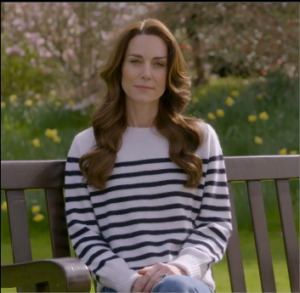
A few weeks ago Princess Catherine revealed that she had cancer
Source: Vox
Early-onset Cancer
Early-onset cancers have different definitions depending on the type of tissue affected. In early-onset breast cancer, this term refers to the diagnosis of someone younger than the age of 45. Regarding early-onset colorectal cancer, it’s present in those younger than 50 (Katella, 2024). As cell damage begins to occur at the age of 50, the probability of being diagnosed with cancer increases as we age. Figure 2 below depicts the percent change in cancer cases for those under 50 from 2010-2019. Between 1999 and 2019, early-onset cancers increased by about 15%, while cancer rates in older people dropped (Bugos, 2024). The highest rates of cancer in younger people were visible in North America, Australia, and Western Europe, demonstrating just how widespread this concern is.
Figure 2
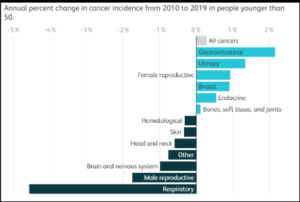
Source: Verywell Health
Which types of Cancer?
Although cancer has become significantly more apparent in younger people, certain types of cancers are more visible in younger people than others. A recent report created by the American Cancer Society (ACS) displayed that while cancer deaths are declining, new cases are on the rise. Many of these new cases involved younger people, with a yearly 1 to 2 percent increase in the number of new people diagnosed.
Common cancers such as breast, cervical, and colorectal, seen in Figure 3, are a major reason for these new cases, with colorectal cancer now being the leading cause of death by cancer in men under 50 (Katella, 2024). Although Chadwick Boseman’s death in 2020 brought more awareness to this condition, physicians have been concerned with colorectal cancer cases for the prior decade. A troubling aspect is that many diagnosed patients were healthy before this. Physicians find this trend worrisome as they aim to identify why it exists.
Figure 3
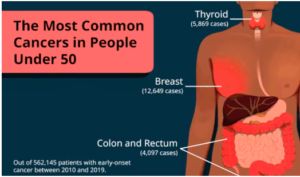
Case numbers on the most common cancers in people under 50
Source: Verywell Health
Unraveling the Rise
Although there is no single factor that is contributing to this escalating trend, it has been discovered that changes in people’s lifestyles are a key component. Dietary factors were seen to correlate with early-onset cancers such as colorectal cancer (Scott, 2024). Deep-fried foods, processed foods, foods that are high in fat, and sugary drinks are items that people are encouraged to avoid as much as possible. In addition, decreasing the consumption of fast food, red meats, and alcohol can, in turn, ensure that one’s likelihood of developing cancer at a younger age is significantly reduced.
Furthermore, physicians advise incorporating fruits, veggies, grains, and fiber-rich foods into a daily diet. A lack of exercise also plays a big role in an increased risk of various cancers. It’s recommended that kids get at least 60 minutes of physical activity daily while adults should strive to reach 150-300 minutes weekly according to the WHO. Physical activity can help regulate some hormones that contribute to cancer development and simultaneously keep the immune system healthy and functional. It also helps to maintain a healthy weight, as being overweight or obese is observed in 14% to 20% of cancer deaths in the US (Simon, 2020).
Recent investigations have unveiled possible new concerns such as toxins in the environment. These include things such as microplastics which are found in everything from food containers and synthetic clothing (Scott, 2024). Microplastics have been seen to cause oxidative damage, DNA damage, and changes in gene activity, all of which are known links to cancer development. Exposure to microplastics is often difficult to recognize due to their variety and size (less than 5 millimeters in length), yet they end up in our bodies and are transported throughout the entire body by the circulation of blood. Statistics on the amounts of microplastics in things people consume are shown below in Figure 4. However, regardless of their lack of potential factors, some younger people who work out, eat healthy, and don’t have any family history of cancer are diagnosed with no apparent cause.
Figure 4
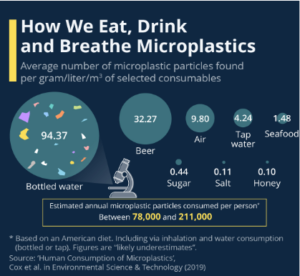
Statistics demonstrating the amounts of microplastics in consumable items
Source: Statista
Cancer Prevention: Can it be Avoided?
Advice on the issue of preventing cancer has remained the same for years – get enough exercise, eat healthy foods, don’t smoke or drink too much, and understand family history and other risk factors. However as mentioned earlier, even taking these measures doesn’t guarantee that people will avoid cancer. Still, it’s imperative that to minimize this risk we monitor our daily habits and make the right decisions concerning our health. Talking to a doctor about any changes or symptoms is critical as most times a delay between the beginning of the symptoms and the actual diagnosis is present (Katella, 2024). People are also advised to get screened for cancer when given the opportunity, as seen in Figure 5. Women can start annual screening for breast cancer at 40 while men can begin to get screened for cancers between the age of 45-50. Despite this, screenings aren’t always effective, and understanding the genetic basis for certain cases provides more insight into the cause (Howard, 2024).
Figure 5
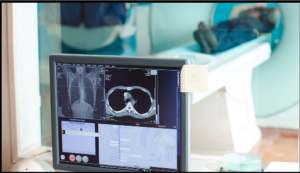
A cancer screen is conducted on a patient
Source: National Foundation for Cancer Research
Future Measures
It is paramount that younger individuals prioritize their health and well-being to mitigate the risk of cancer onset. The alarming surge in cancer diagnoses among this demographic underscores the urgency of proactive health management. By adopting healthy lifestyle choices, including regular exercise, balanced nutrition, and avoidance of harmful habits like smoking and excessive alcohol consumption, individuals can significantly reduce their susceptibility to cancer. Furthermore, physicians and healthcare professionals play a pivotal role in identifying emerging trends and patterns in cancer incidence among younger populations. By closely monitoring these trends, healthcare providers can strive to curb the upward trajectory of cancer cases in younger individuals.
References and Sources
Abbott, B. (2021, January 11). Cancer is striking more young people, and doctors are alarmed and … The Wall Street Journal. https://www.wsj.com/health/healthcare/cancer-young-people-doctors-baffled-49c766ed
Bugos, C. (2024, January 22). Why is cancer rising in young adults? Verywell Health. https://www.verywellhealth.com/rising-cancer-rates-in-young-people-8404730
Howard, J. (2024, January 17). Cancer incidence rising among adults under 50, a new report finds, leaving doctors puzzled and worried. CNN. https://www.cnn.com/2024/01/17/health/cancer-incidence-rising-report/index.html#:~:text=Among%20adults%20younger%20than%2050,and%20women%20younger%20than%2050.
Katella, K. (2024, March 4). What to know about rising rates of “early-onset” cancer. Yale Medicine. https://www.yalemedicine.org/news/early-onset-cancer-in-younger-people-on-the-rise#:~:text=The%20ACS%20report%20showed%20younger,year%20during%20that%20time%20period.
Scott, D. (2024, March 22). Kate Middleton’s cancer diagnosis is part of a frightening global trend. Vox. https://www.vox.com/future-perfect/24108991/kate-middleton-catherine-wales-cancer-trends-diagnosis-youth
Simon, S. (2020, February 19). How exercise can lower cancer risk. American Cancer Society. https://www.cancer.org/cancer/latest-news/how-exercise-can-lower-cancer-risk.html#:~:text=Physical%20activity%20can%20help%20regulate,and%20helps%20the%20immune%20system.